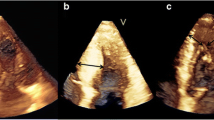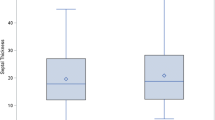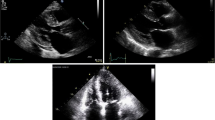Abstract
The relationship between cardiac shape and the age of patients with hypertrophic cardiomyopathy (HCM) has been established, and echocardiography has been accepted as the best method to quantitate ventricular cavity geometry. Recently, real-time three-dimensional volumetric data have demonstrated that children and young, middle-aged, and elderly patients with HCM have different morphologic and prognostic characteristics. This review discusses the importance of phenotypic expression and describes secondary factors that may affect ventricular cavity geometry during the progression of HCM.
Similar content being viewed by others
References
Goodwin JF. The frontiers of cardiomyopathy.Br Heart J. 1982;48:1–18.
Maron BJ, Spirito P, Wesley Y, et al. Development and progression of left ventricular hypertrophy in children with hypertrophic cardiomyopathy.N Engl J Med. 1986;315:610–614.
Lompre AM, Nadal-Ginard B, Mahvadi V. Expression of the cardiac ventricular α- and β-myosin heavy chain genes is developmentally and hormonally regulated.J Biol Chem. 1984;259:6437–6446.
Ojamaa K, Samarel AM, Kupfer JM, et al. Thyroid hormone effects on cardiac gene expression independent of cardiac growth and protein synthesis.Am J Physiol. 1992;263:E534-E540.
Semsarian C, French J, Trent RJ, et al. The natural history of left ventricular wall thickening in hypertrophic cardiomyopathy.Aust N Z J Med. 1997;27:51–58.
Vitale DF, Bonow RO, Calabro R, et al. Myocardial ultrasonic tissue characterization in pediatric and adult patients with hypertrophic cardiomyopathy.Circulation. 1996;94:2826–2830.
Okada H. An investigation of the collagen in cardiomyopathic hamsters.Hokkaido J Med Sci. 1993;68:894–905.
Hamby RI, Antablian A. Hypertrophic subaortic stenosis is not rare in the eighth decade.Geriatrics. 1976;31:71–74.
Berger M, Rethy C, Goldberg E. Unsuspected hypertrophic subaortic stenosis in the elderly diagnosed by echocardiography.J Am Geriatr Soc. 1979;27:178–182.
Lever HM, Karam RF, Currie PJ, et al. Hypertrophic cardiomyopathy in the elderly: distinction from the young based on cardiac shape.Circulation. 1989;79:580–589.
Cohen S, Benichou M, Larbi MB, et al. Myocardiopathie hypertrophique: evolution et pronostic. Soixante observations.Presse Med. 1986;15:423–427.
Spirito P, Maron BJ. Relation between extent of left ventricular hypertrophy and age in hypertrophic cardiomyopathy.J Am Coll Cardiol. 1989;13:820–823.
Klues GK, Schiffers A, Maron BJ. Phenotypic spectrum and patterns of left ventricular hypertrophy in hypertrophic cardiomyopathy: morphologic observations and significance as assessed by two-dimensional echocardiography in 600 patients.J Am Coll Cardiol. 1995;26:1699–1708.
Krasnow N, Stein RA. Hypertrophic cardiomyopathy in the aged.Am Heart J. 1978;96:326–336.
Whiting RB, Powell WJ Jr, Dinsmore RE, et al. Idiopathic hypertrophic subaortic stenosis in elderly.N Engl J Med. 1971;285:196–200.
Wadehra D, Ganar RM, Scanlon PJ. Prognosis of hypertrophic cardiomyopathy with asymmetric septal hypertrophy.Postgrad Med J. 1985;61:1107–1109.
Savage DD, Castelli WP, Abott RD, et al. Hypertrophic cardiomyopathy and its markers in the general population. The great masquerade revisited: the Framingham study.J Cardiovasc Ultrasonogr. 1983;2:41–47.
Brock R. Functional obstruction of the left ventricle (acquired aortic subvalvular stenosis).Guys Hosp Rep. 1957;106:221–238.
Yalçin F, Tsujino H, Greenberg N, et al. Real-time three-dimensional echocardiographic evaluation of mitral annular characteristics in myocardial hypertrophy.Eur Heart J. 1999;291:P1599.
Yalçin F, Shiota T, Odabashian J, et al. Comparison by real-time three-dimensional echocardiography of left ventricular geometry in hypertrophic cardiomyopathy versus secondary left ventricular hypertrophy.Am J Cardiol. 2000;85:1035–1038.
Spirito P, Maron BJ. Absence of progression of left ventricular hypertrophy in adult patients with hypertrophic cardiomyopathy.J Am Coll Cardiol. 1987;9:1013–1017.
Spirito P, Chiarella F, Carratino L, et al. Clinical course and prognosis of hypertrophic cardiomyopathy in an outpatient population.N Engl J Med. 1989;320:749–755.
Hina K, Kusachi S, Iwasaki K, et al. Progression of left ventricular enlargement in patients with hypertrophic cardiomyopathy: incidence and prognostic value.Clin Cardiol. 1993;16:403–407.
Vikstrom KL, Factor SM, Leinwand LA. A murine model for hypertrophic cardiomyopathy.Z Kardiol. 1995;84:49–54.
Spirito P, Maron BJ. Significance of left ventricular outflow tract cross-sectional area in hypertrophic cardiomyopathy: a two-dimensional echocardiographic assessment.Circulation. 1983;67:1100–1118.
Qin JX, Shiota T, Lever HM, et al. Left ventricular outflow tract area measured by real-time 3D echocardiography in hypertrophic obstructive cardiomyopathy.J Am Soc Echocardiogr. 1999; 12:202M.
Ciro E, Maron BJ, Bonow RO, et al. Relation between marked changes in left ventricular outflow tract gradient and disease progression in hypertrophic cardiomyopathy.Am J Cardiol. 1984; 53:1103–1109.
Horimoto M, Yokota K, Inoue H, et al. Development of obstructive hypertrophic cardiomyopathy from nonobstructive hypertrophic cardiomyopathy.Am J Cardiol. 1998;82:403–405.
Krasnow N. Subaortic septal bulge simulates hypertrophic cardiomyopathy by angulation of the septum with age, independent of focal hypertrophy. An echocardiographic study.J Am Soc Echocardiogr. 1997;10:545–555.
Watkins H, McKenna WJ, Thierfelder L, et al. Mutations in the genes for cardiac troponin T and α-tropomyosin in hypertrophic cardiomyopathy.N Engl J Med. 1995;332:1058–1064.
Solomon SD, Jarcho JA, McKenna WJ, et al. Familial hypertrophic cardiomyopathy is a genetically heterogeneous disease.J Clin Invest. 1990;86:993–999.
Ojamaa K, Samarel AM, Kupfer JM, et al. Thyroid hormone effects on cardiac gene expression independent of cardiac growth and protein synthesis.Am J Physiol. 1992;263:E534-E540.
Fei L, Slade AK, Prasad K, et al. Is there increased sympathetic activity in patients with hypertrophic cardiomyopathy?J Am Coll Cardiol. 1995;26:472–480.
Shimizu M, Sugihara N, Kita Y, et al. Long-term course and cardiac sympathetic nerve activity in patients with hypertrophic cardiomyopathy.Br Heart J. 1992;67:155–160.
Schafers M, Dutka D, Rhodes CG, et al. Myocardial presynaptic and postsynaptic autonomic dysfunction in hypertrophic cardiomyopathy.Circ Res. 1998;82:57–62.
Limbruno U, Strata G, Zucchi R, et al. Altered autonomic cardiac control in hypertrophic cardiomyopathy. Role of outflow tract obstruction and myocardial hypertrophy.Eur Heart J. 1998;19:146–153.
Dimitrow PP, Czarnecka D, Jaszcz KK, et al. Sex differences in age at onset of symptoms in patients with hypertrophic cardiomyopathy.J Cardiovasc Risk. 1997;4:33–35.
Lompre AM, Nadal-Ginard B, Mahdavi V. Expression of the cardiac ventricular α-and β-myosin heavy chain genes is developmentally and hormonally regulated.J Biol Chem. 1984;259:6437–6446.
Rohde LE, Zhi G, Aranki SF, et al. Gender-associated differences in left ventricular geometry in patients with aortic valve disease and effect of distinct overload subsets.Am J Cardiol. 1997;80:475–480.
Legget ME, Kuusisto J, Healy NL, et al. Gender differences in left ventricular function at rest and with exercise in asymptomatic aortic stenosis.Am Heart J. 1996;131:94–100.
Author information
Authors and Affiliations
Corresponding author
Rights and permissions
About this article
Cite this article
Yalçin, F., Muderrisoglu, H., Korkmaz, M.E. et al. Do variable age-related secondary factors affect ventricular geometry in hypertrophic cardiomyopathy?. Adv Therapy 19, 253–257 (2002). https://doi.org/10.1007/BF02853170
Issue Date:
DOI: https://doi.org/10.1007/BF02853170




